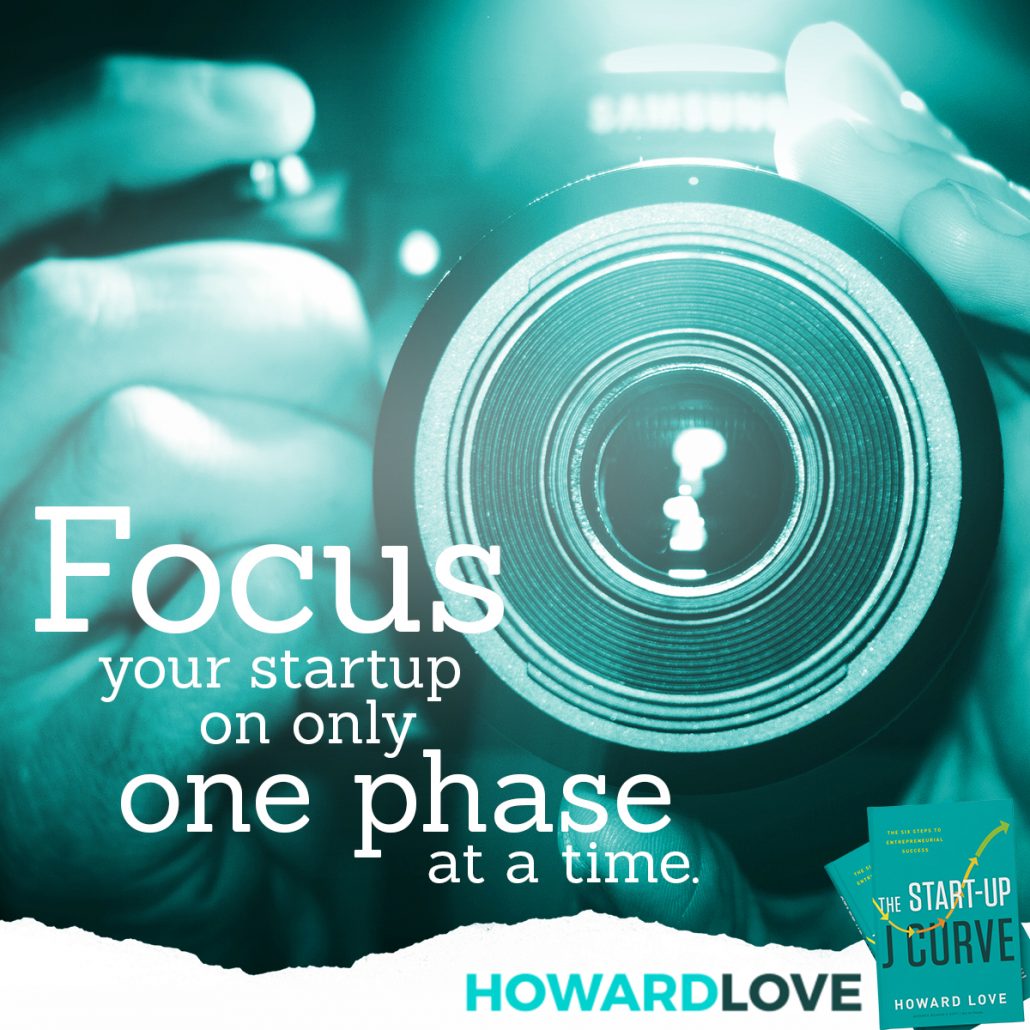Howard Love’s Blog
Things I’ve learned from very expensive lessons.
The Fog of Startups
/in Uncategorized /by Howard LoveThere is a documentary called “The Fog of War” (won an Academy Award) that describes decision making in a war. It features Robert McNamara, who was Secretary of Defense in the context of Vietnam. Wars are very messy and the information available to the generals and decision-makers is usually very imperfect and incomplete. Nevertheless, decisions are required or lives are at risk.
In startups, it’s often quite similar, where your information is very imperfect, but the cost in terms of time (which is money) of gathering all the info is simply too high. Collecting all the information is a luxury. Large companies may have that luxury, or perceive that they do, but startups don’t. In startups speed is critical and decisions are required to move forward quickly.
What people often miss is that most decisions are reversible. There is a small cost of doing so, employees may feel a little whiplashed by the speed of decisions or reversals. But that is way better in most cases than failing to make a decision.
Startup investing is very similar. It’s messy, you don’t have all the information. You find out as much as you can, but you’ll never know and it’s almost never an easy decision. I’ve lost more money on easy decisions than hard decisions.
If you’re going to be in the startup world, either as a founder, employee or investor, you need to be comfortable with uncertainty. You need to be comfortable with the fog of startups.
You Can’t Get Rich Selling
/in Uncategorized /by Howard LoveNote: This article is not intended to provide investment advice, rather it reflects my personal style and observations over the past 35 years that I have been studying and practicing investing as an startup angel, VC, real estate and stock market investor. I believe that there is a different investment style for everyone and you need to find the one that you are most comfortable and that your personality is best suited. The method I follow is not for everyone, and it has subtleties and complexities that can only be appreciated over a very long time period of time. It also represents an “offensive” rather than “defensive” game. It focuses on maximizing wealth creation, not necessarily wealth preservation, and as such, can create wide swings in your portfolio valuation. It also looks best in a strong bull market such as we have enjoyed, and will look questionable at the bottom of a bear market. Many would consider this high risk, though I do not. I am not suggesting that you do this, instead I am explaining what I personally do. As they say: Consult with your investment advisor.
Today’s equity investment news and advice is heavily biased towards transactions and an implication that you improve your investment returns by jumping in and out of a stock or market (just watch CNBC for a few minutes). I think that the odds of becoming wealthy by jumping in and out of the market are very slim indeed. I’ve only met one person in my life who can genuinely do this for an extended period of time, and that was Stanley Druckenmiller. He worked for George Soros who could also play this game. I would guess there are another 5-10 in the world who can pull it off and produce above-market, after-tax returns over 10 years or more. Trust me; you can’t. Moreover, you wouldn’t even want to, because just trying would be all-consuming and likely make your life miserable.
What I have found to be most effective is precisely the opposite: Fewer trades and longer holding periods produce better returns. It’s worth noting that the average holding period of the primary investment of a person near the top of the Forbes 400 is over 40 years.
I’ve studied Warren Buffett endlessly, and I believe that the most overlooked aspect of his method and genius is the length of the holding period of his investments. The average holding period of his top 10 public investments is well over a decade. Also, ever notice how generally happy Warren is? He’s not stressing out about what second to sell a big position; I doubt he gives it much thought. And note that if you are not spending a lot of time on the question of when to sell, that allows more time to focus on the more important question of what and when to buy.
Ever wonder why for most people, their most significant asset is their house? It’s mostly because they have owned it the longest. Also helpful is that the government subsidizes the mortgage cost and that a mortgage is a form of forced savings. Finally, since it is not priced every day, people don’t have to wonder whether today is a good day to sell. They are also not inclined to sell it because they actually need a place to live. So the result is that it’s the one investment that, for most people, they own the longest.
The law of compounding is an investor’s best friend: Einstein called it the 8th wonder of the world. That law of compounding has two primary components – the rate of return and time. Of the two, you have limited control over the rate of return, but you do have control over the length of time that you hold an investment. Most people obsess over the specific investment but give little consideration to the length of time that they will hold that investment. Since I plan on holding the investment for a long period of time, it needs to have the characteristics that that will help it survive and thrive over a very long period of time. Typically, that means a business with a competitive advantage, that it has a “moat” to protect it from the competition and run by a capable and shareholder-friendly manager. Another positive effect of the long hold strategy is that it encourages you to front-load your analysis and try to get a reasonably high degree of certainty prior to investing that you have selected a great business. Time is the friend of a good business and the enemy of a poor one.
One key ingredient to holding investments for an extended period, paradoxically, is that you can’t need the money. You especially don’t want to get yourself in a situation where, when the market conditions are poor, suddenly you realize that you need that money to pay your mortgage. If you find yourself in that situation, your life will be miserable, and you won’t be able to sleep at night. The hardest part about holding investments for an extended period of time is to continue to hold them, indeed possibly buy more, when they go down in value – as all investments do from time to time. One needs to be able to ride out these bumps and still sleep at night. That’s why holding investments for a long period of time is truly a luxury. Ideally, you want another source of cash flow so you can invest on a regular basis.
Charlie Munger (Warren Buffett’s partner) once said that you should be prepared for your stock investments to decline by 50%; otherwise you shouldn’t be playing the game (paraphrased). To be clear, holding onto investments when they decline by 50% is very, very hard. Importantly, you don’t want to find out that you are not cut out for it at the bottom of the decline – that will just kill your returns. So, you need to ask yourself frequently, will I be OK if my portfolio declines by 50%. Better yet, ask yourself if you would have the guts to invest more when the market is down by 50%, and everyone you know is negative, and they are screaming at you on CNBC that anyone who owns stocks is an idiot.
While sometimes I think I could write a small book on the subtleties of this, there are a couple of essential points. First, one needs to be prepared for the fact that some investments will “round-trip,” meaning that after buying them, they will go up and then come right back to where you bought them and maybe lower. Also, some investments will be turkeys and head straight south, never to return. Finally, (and this is critically important) when you have a winner, it will become a large percentage of your portfolio if you don’t sell it. The common wisdom is that the “prudent” thing to do is to “take a little off the table.” While doing so may (or may not) be prudent, it can be counter-productive to wealth creation (as opposed to wealth preservation). An investor’s winners need to make up for the inevitable losers. Personally, I cringe when I hear the phrase “take some money off the table” or “take back my bacon” or “you never go broke taking a profit.” This is also very true in angel investing, and in fact there is a term for it called the power law. Maximizing the winners is so important because you know there will be losers – including plenty of wipeouts. So if you never sell, you hopefully end up with what most would consider an “unbalanced” portfolio, which again I don’t see as a bad thing (though many do). After all that is what I wanted – for one or a small handful of stocks to just take off and never look back.
As I explain in my book, The Start-Up J Curve, I follow this philosophy in my angel and venture investments as well, often much to the surprise of the founders I invest in. They know that most of their investors want “liquidity” and often feel very real pressure to deliver that. Personally, I am usually chagrinned when my successful angel investments are sold. When I get the proceeds from that sale, I am grateful, but now I need to go try to find another great company and I know that is very, very hard. I’m also likely going to have to suffer through the long, cold winter of the Start-up J Curve (ouch). I also wince when I see venture capital funds I am invested in sell early and I would argue that it generally hurts their returns.
How long is a long holding period? I’d say the longer, the better, but you want to be thinking 10-15 years or more. The goal is to have a significant investment in a company that stands the test of time and keeps working for you every day, year in and year out. I don’t personally think in terms of holding period, as I want to hold my investments forever – because I believe that You Can’t Get Rich Selling!
Important note: Again, I am sharing my personal observations and investment style, which may not be appropriate for you and your financial situation. Consult with your financial advisor before making any investments.
Observational Reality vs. Scientific Proof
/in Uncategorized /by Howard LoveWestern thought is heavily based on reason and one of the key underpinnings of
reason is scientific proof. We therefore all are somewhat slaves to that which is
“proven” and this reliance produces a critical weakness in that much of what we
considered “proven” is often subsequently proven wrong and much of what we
intuitively suspect is right remains unproven. The more I go through life, the more
I’ve become aware of the shortcomings of scientific proof and the more I am
compelled by what I would term “observational reality.”
Here is a sweet example of observational reality: uncommon amounts of super-aged
people, say those who live beyond the age of 100, eat chocolate. My wife and I were
blessed to have two grandmothers live to age 100 and they were both chocoholics.
One of the oldest people to ever live, Jeanne Calment, who lived to the ripe age of
122, also was known to love chocolate and had a daily “dose.” At some point in the
last couple of decades, scientists seemed to have noticed the same and so, as
scientists are wont to do, they set out to find if there was a scientific explanation.
They found that indeed there are elements of chocolate that provide several health
benefits, but only if taken in large doses and specifically, the best way to access
those benefits were through dark chocolate. These findings unleashed a torrent of
dark chocolate products in the marketplace. But, here is where the science and our
grandmothers diverge. You see our grandmothers ate regular milk chocolate like
M&M’s and generic Hersey bars, not fancy and expensive craft dark chocolates and
I’d venture to say, neither did Jeanne Calment. You see, dark chocolate doesn’t taste
as good as milk chocolate and as a result perhaps you would not eat as much of it,
thereby reducing the effectiveness of the whole notion. In fact, it could well be that
dark chocolate is actually less effective than milk chocolate because fewer people
love dark chocolate enough to make it a habit. Maybe it all has little to do with the
chemical elements in the chocolate, and the benefit is largely as result of the simple
daily elation of taking a minute to enjoy something that tastes great. Who knows?
Who cares?
So I think its fair to say that science has not caught up with our grandmothers yet.
Science has found some elements, which seem to help explain, but they haven’t
gotten to the complete explanation and it’s a fair bet that they wont for quite some
time.
The point here is that you don’t need to know the science to know what is effective
in life. The “why” is interesting, but not a requirement. If you observe that a
preponderance of very old folks eat chocolate, then you’re likely well served to
imitate that wonderful habit. Enjoy the chocolate today, the science will eventually
catch up.
WHAT’S YOUR WHY?
/in Uncategorized /by Howard LoveKnowing your Why doesn’t seem very important when everything is going wonderfully. When life is grand we are usually not asking the deep inconvenient questions, such as: What am I doing with my life and WHY am I doing it? Frankly who cares? Life is awesome, pass the champagne! However, when things get rough in life, as they invariably do, the WHY becomes the most important question of all. And if you don’t have a good why when you are in that ridiculously rough patch, you’re doubly screwed. Sometimes I think life throws us into tough situations just so we can directly confront our why and test it to see if it’s solid. If your Why is weak, then you need to upgrade it, and the sooner the better. Below is an excerpt from my book, The Start-Up J Curve, where I discuss the importance of having a solid Why as it relates to startups and their founders. My friend, former Navy SEAL Mark Divine, had great advice on this.
WHAT’S YOUR WHY?
Whether you are a missionary or a mercenary raises the fundamental question of why you are embarking on your start-up journey. My friend and former Navy SEAL Commander, Mark Divine, boils it down to this question: “What is your why?” Mark was ten years active on SEAL teams and ten years in the reserves. He then started a company called SEALFit that helps train prospective SEALs as well as civilian adventurers to test themselves. SEALFit’s ultimate test is called Kokoro Camp, and it’s a fifty-hour, nonstop crucible training event modeled after the Navy SEAL Hell Week. That is fifty hours straight of hard-core mental and physical exertion, with no sleep. Less than 50 percent of the class will finish the ordeal. At some point during the camp, Mark asks students to state their why for attending the camp. Mark can often get a strong sense of whether they will successfully complete the training based on their answers.
Here are some typical responses to the why question:
- “I am here to prove that I am tough enough to be a Navy SEAL.” (This is not a strong why, and these guys often fail.)
- “I want to prove to my two daughters that I am strong and will always be there for them.” (Lottery winner! This woman crushed it.)
- “I want to meet my true self and push through my self-imposed limitations.” (This is a solid why.)
- “My father enrolled me and I want to prove to him I am worthy of this program.” (This is another fail.)
According to Mark, “The key point here is that when the dark night of the soul moment comes, when your mind and body say they are done, and if the student can’t dig into a deep reservoir of inspiration to continue, then they won’t. The why is the tap to that reservoir, and having a powerful why that is intrinsic and deeply meaningful is required to stay the course through the most trying times.” The missionaries know their why, and it is something bigger than themselves. The mercenaries may not know their why because it’s all about them; they don’t have a larger purpose.
Navy SEAL Hell Week training is particularly relevant with respect to pushing through as opposed to quitting. The primary objective of Hell Week for the Navy is to smoke out the quitters. They need the quitters gone quickly for two reasons. The first is a simple investment issue: They don’t want to put time and money into training those who are going to eventually quit, since it’s a bad allocation of resources. Second, and perhaps more importantly, it’s a matter of life or death. The one thing that SEALs cannot have happen under any circumstances is for a team member to quit in the middle of a firefight. If that happens, there is a good chance that somebody may get killed. Needless to say there is nothing touchy feely about Hell Week, no kumbaya sessions; rather, the drill instructors are purposely trying to get you to quit. You better have a good why or you are going to be crawling over to ring the bell, thereby ringing out and joining the more than 75 percent who quit.
While start-ups may not be life or death literally, they are exactly that figuratively. In start-ups, you will be tested in many ways, and more than once, you’ll probably consider quitting. The strength of your why will determine whether you have the determination to push through the adversity to success. Be conscious about your own missionary and mercenary tendencies. Ask yourself what type of product or business will trigger your missionary impulse and help you build a start-up around it. If you choose something that you are passionate about and through which you have a chance to make a significant impact, you’re not only more likely to be successful financially, but you’re also more likely to have a fulfilling and meaningful start-up experience. Therefore:
- pursue what really turns you on, what you’re super passionate about;
- focus on products and services that are fun and have some social utility;
- find people with whom you really enjoy working;
- realize that you’re on a journey;
- embrace the unknown; and
- refuse to give up, unless you are out of ideas or your health is jeopardized.
So work on your why, have it nailed BEFORE you have your back against the wall.
Focus on the Product before the Business Model
/in Uncategorized /by Howard LoveIt’s not unusual for entrepreneurs to get ahead of themselves. Entrepreneurs are aggressive and opportunistic, their pace accelerated by their hopes and dreams. Doing things in the wrong order, however, is one of the surest ways of sabotaging your start-up; and doing them in the right J Curve order (Create > Release > Morph > Model > Scale > Harvest) is one of the best ways of ensuring its success.
Consider two of the most common chronology mistakes:
- Focusing on the business model before figuring out the product
- Scaling before nailing the product or business model
You’re likely to make the first mistake because when you explain your new idea to people, you’ll be peppered with questions such as, “How are you going to make money at that?” While you don’t want to ignore that question completely, the real questions to ask yourself are “Can I make something people will really want?” and “Can I get customers to actually use my product or service?” Because if you can’t get people to use your product or service, then you are not going to make any money at it anyway. What history generally has proven is that if you can get customer traction, you can find a way to make money. By focusing too much on the revenue model, you may be creating a myopic view of what your idea should be and blocking yourself from considering some important paths for evolving your initial idea. However, it might be one of those alternate paths or a later iteration that brings you the most customer traction. In addition, you waste valuable time being overly focused on the business model early on because you don’t yet know what the actual product will be. You may go through two, three, or more iterations of the product, and by the nth iteration, the model you created for the first iteration will be hopelessly inappropriate. Paradoxically, emphasizing a business model prematurely, you may block yourself from the best money-making opportunities. You’ve structured the company in a certain way and hired people with certain types of experience
to capitalize on the first product. Most organizations aren’t sufficiently agile to shift as their product shifts, so they may have the right product but the wrong business model.
It’s only when you gain significant customer traction with a product iteration and you are through the Morph phase that you should spend significant time on the business model.
Avoiding this mistake requires patience, a virtue that some entrepreneurs find is in short supply. Following the proper order will allow you to focus all your resources and attention on the phase you are in, so you can nail it and move your startup to the next phase.





